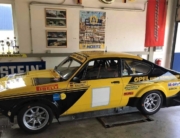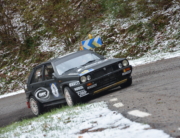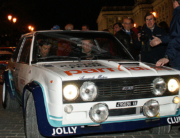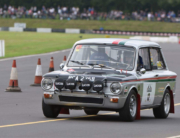
Nearly four months before it begins, RallyClassics already has over 70 participants signed up. 24th and 25th March, 2017: two days of competition with base camp in Girona.
The 65th Moritz Costa Brava Rally is being held on 24th and 25th March, 2017. This year’s significant event, which establishes the Costa Brava as the oldest rally in Spain, will take place around the hub of the city of Girona. The route is to include 12 sections of asphalt roads totalling 170 km of speed or regularity racing, all closed off to normal traffic.
The main new highlight of the race is that a top-class brand deeply rooted in the country’s culture, Moritz beers, is lending its name and logo to the Rally Costa Brava, which this year will be officially called the 65th Rally Moritz Costa Brava. The sponsorship agreement for the next three years was signed by the RallyClassics president, the former world racing driver Alex Romani, and Santi Manzano, the chairman of the beer brand from Barcelona, Moritz.
In essence, the Costa Brava Rally and Moritz have a lot in common, and this harmony is summed up in their passion for enjoyment of the road laid down by the past that has paved the way for today’s success. By joining forces, the two brands are going to have significant impact and visibility, providing added value that goes beyond the competition alone, basing their goals on a good atmosphere and entertainment for spectators and participants alike.

To celebrate this 65th edition in great style and bring it to the general public as far as possible, the start and finish podium will be located at the heart of the city of Girona, on Avinguda Ramón Folch, next to La Plaça de la Independència, whereas the new technical assistance zone will be located in the Fontajau-Domeny district next to the Fontajau sports centre, where the pre-race verifications will be made. This venue’s capacity will be able to comfortably host the assistance teams for up to 120 historical cars participating, including the Speed, Legend and Regularity categories.
In addition to being able to count on a new companion for the journey, Moritz, one of the great new sporting highlights in this edition will be the participation of the so-called Legend vehicles: racing cars of great historical value that will take part as exhibition pieces without being timed in eight of the sections over a total of 120 km.
The interest aroused among teams and drivers in expectation of this special 65th edition is clear, since four months before it starts RallyClassics already has 50 participants signed up in the three categories. The list is truly extraordinary, with top-level drivers and machines, many of them from beyond our borders: Erik Comas (Lancia Stratos HF), “Lucky” (Lancia Rally 037), Paolo Baggio (Lancia Rally 037), Jean-François Mourgues (Porsche 911 Carrera), Max Girardo (Fiat 131 Abarth), Vaison (Lancia Rally 037), Antonio Sainz (Porsche 911 RS 3.0), Martín Arroyo (Opel Manta 400 ex-GM Spain), Josep Pujol (Lancia Rally 037 ex-Carlo Capone), Xavi Piña (Lancia Stratos), Gary Gee (Talbot Sunbeam Lotus), Christian Duzy (Porsche 911 SC ex-Carlos Sainz), Adam Marsden (Audi Quattro A1), Anders Johnsen and Mats Myrsell (both with a Porsche 911 Carrera RS), Daniel Alonso, Cele Focueva and Serge Cazaux (the three with a Ford Sierra Cosworth 4×4), Christophe Jacob, François Foulon, Jason Pritchard and Christophe Demortier (all four with a Ford Escort RS), Valter Ch. Jensen, Francesc Gutiérrez, Xavi Domènech and Jordi Gaig (the three with a BMW M3), and many more.

The Moritz Costa Brava Rally is not only the oldest on the Spanish calendar; it is also one of the most prestigious on the international scene, in addition to Moritz being the beer company with the longest history in Barcelona. Both brands are seen with fondness and their management have been working for many years to grow towards this goal, based on passion and quality. Moritz’s likeable, extensive fleet of SEAT 600s harks directly back to the sixties, which is the decade when the Costa Brava Rally began to blaze its prestigious trail.
The 65th Moritz Costa Brava Rally is still the top race on the European FIA’s calendar for historical cars. Base camp will continue to be at the Hotel Ultònia, which has collaborated with the CBR since the 60th edition, when the race came to Girona with the helping hand of the man who is now President of Catalonia, Carles Puigdemont, then the city’s mayor. To commemorate this 65th anniversary edition, RallyClassics is organising a photo display that will show magic moments from these first 65 years of history.
1953: the year when it all began
It was on 10th May, 1953, when the first “Costa Brava Rally” took place, organised by the “10 km per hour Motorists’ Club” (“Peña Motorista 10 km por Hora”) with the help of the Barcelona Motorists’ Club (“Peña Motorista Barcelona”), a very expert club in those days for organising this kind of event. No fewer than 40 motorcycles took part, but there were only three automobiles. All of these vehicles had to tackle a route that was very tough for those times, starting in Barcelona with a morning route bordering the Costa Brava and a time checkpoint in Sant Feliu de Guixols, then an arrival and new time checkpoint in Cadaqués, where the stage finished and they gathered their strength again.
In the afternoon, the participants made their way southwards, inland now, with a time checkpoint in Sils (Hostal de la Selva) and finish line in Barcelona, all the time with one average speed of 55 km/h to be matched by all the vehicles. Although the race in those early editions was really a tourist outing with no atmosphere of sport, one should not forget the difficulty in having to keep up this average all the time to arrive at the checkpoints on time along roads open to normal traffic, which in the early fifties were in a state that was nothing like the conditions to be found a decade or two later.
The four time checkpoints in that first edition determined the classification. Only eight vehicles—two cars and six motorbikes—managed to end the rally on time, with the winners being named as the president of the Barcelona Motorists’ Club, Mariano Cugueró, accompanied by his wife (Seat 1400) for cars, and Conrado Cadirat (Ossa) for motorcycles. Jorge Galofré (Lancia) also finished on time, as did Juan Vidal (Ossa), Francisco Tombas (Derbi), José A. Maseras (Derbi), Juan Morsa (Montesa) and Juan Dalmau (Montesa); all of them classifying in that order according to the organiser.
The hall of fame from the five pioneering Costa Brava Rallies reads as follows:
1953 • Mariano Cugueró (Fiat 1400) • Conrado Cadirat (Ossa)
1954 • Kurt J. Bahr (Simca) • Conrado Cadirat (Ossa 125)
1955 • Juan Dalmau (Citroën) • Francisco J. Anet (Montesa)
1956 • Manuel Almirall (Lancia) • Francisco Romañá (Sanglas)
1957 • Kurt J. Bahr (Ford Taunus) • Conrado Cadirat (Ossa 175)
14th Historic Costa Brava Rally, 4 weeks later in Palamós
From 20th to 23rd April in Palamós, the regularity rally is to be held on the open road: the 14th Costa Brava Historic Rally. The scores will be valid for the FIA Trophy for Historic Regularity Rallies. There are expected to be a great many participants, since this is the most popular rally on the calendar.
After 13 years in Lloret de Mar, the next three editions will have their main base camp in the sea-faring town of Palamós, with its two ports; an excellent spot to blend gastronomy with the best stretches of road and an official village (with an enclosure, podium, assistance area and slalom section) on the seaside promenade itself. The rally’s headquarters will be housed in the Hotel Trias in Palamós, and the secondary bases will be in Banyoles and Puigcerdà.
Source: JAS
Photographies: Ramon Puig, Adrià Masferrer, Jaime Palau-Ribes












